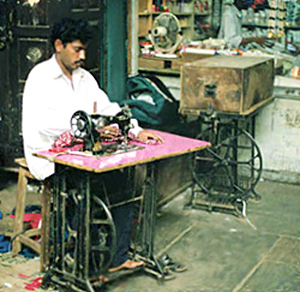 Chhipa Caste
Chhipa Caste
Description:
The Chhipa caste, a Hindu community primarily residing in Northern India, is renowned for their expertise in cotton printing and dyeing. With a rich history and distinct cultural practices, the Chhipa community has contributed significantly to the textile industry. They are mainly associated with dyeing cloths in red, blue or black colours with ornamental patterns.
The Chhipa caste is a Hindu community primarily residing in Northern India. They are known for their expertise in cotton printing and dyeing, which has been their traditional occupation for generations. The origin, subdivisions, cultural practices, and geographical distribution of the Chhipa caste play a significant role in development and evolution of the textile industry in India.
Etymology of Chhipa Caste
The Chhipa caste is recognized by various names across different regions of Central India. In the northern districts, they are commonly referred to as Chhipa, while in the Maratha region, they are known as Rangari or Bhaosar. It is important to note that the Chhipas and Rangaris do not intermarry, although there are no substantial distinctions between these two groups. Both Chhipas and Rangaris share a functional origin and pursue the same occupation. The term Nilgar or Nirali is applied to Chhipas or Rangaris who work as indigo cultivators, while the term Bhaosar is used for Rangaris in the northern parts.
Legends on the origin of Chhipa Caste
Legends surrounding the origin of the Chhipa or Rangari caste provide different narratives. According to one legend, during the period when Parasurama, the incarnation of Vishnu, was eliminating the Kshatriyas, two brothers from the warrior caste sought refuge in a temple. The goddess protecting them instructed the brothers to adopt the profession of dyers. The Rangaris are believed to be descendants of the brother called Bhaosar, while the Chhipas are said to have descended from the brother who hid behind the temple image. As a result, their name is derived from the Hindi term `chhipna`, meaning to hide.
Another interpretation suggests that their name stems from the term `chhapna,` which means to print. This interpretation aligns with the Chhipas` practice of creating colored patterns on cotton cloth using wooden stamps. In an alternative version of the legend, the goddess bestowed one brother with a needle and thread and the other brother with a red betel leaf, assigning them the professions of tailor and dyer, respectively. Consequently, they came to be called Chhipi or Shimpi and Chhipa, highlighting the connection between the tailoring and dyeing castes of the Maratha region.
Geographical Distribution of Chhipa Caste
The Chhipa caste is found in several states of India, including Gujarat, Rajasthan, Madhya Pradesh, Haryana, Delhi, and Uttar Pradesh. In Gujarat, they predominantly reside in the districts of Ahmedabad, Nadiad, Baroda, and Bharuch. The Chhipa community originated in Nagaur, Rajasthan, and subsequently settled in different parts of India. The community`s primary occupation remains dyeing and printing cloth, although some members have ventured into trade or secured employment in local textile mills.
Subdivisions in Chhipa Caste
The Chhipa community encompasses various subdivisions, referred to as ataks, with the prominent ones being Rao, Tak, Bhati, Doera, Chauhan, and Molani. Interclan marriages are prevalent, and the community does not exhibit a distinct preference for cross-cousin or parallel-cousin marriages. The Chhipas predominantly speak Gujarati, with some also conversant in Kutchi, Marwari, and Hindi languages.
Society and Culture of Chhipa Caste
The Chhipa caste practices marriage restrictions based on common ancestry, prohibiting unions between individuals with close familial ties. However, divorce and widow remarriage are permitted within their society. Funeral rites involve the cremation of the deceased. On the occasion of Dussehra, Chhipas worship wooden stamps, a significant tool in their printing and dyeing craft. This ritual involves offering coconuts and flowers as a mark of reverence. The Chhipas demonstrate their artistic flair by adorning sarees, floor coverings, and bed-cloths with a wide array of intricate designs in vibrant colors, showcasing their mastery in the craft of cotton printing and dyeing.
Contemporary Occupation of Chhipa Caste
The Chhipa community has preserved its traditional occupation of dyeing and printing cloth, with many individuals actively engaged in this craft. Additionally, some community members have ventured into business enterprises or secured employment in local textile mills, contributing to the thriving textile industry in their respective regions. In recognition of their socioeconomic status and historical occupation, the Chhipa caste is classified as an Other Backward Class (OBC) in the Indian states of Haryana, Delhi, Rajasthan, Madhya Pradesh, and Uttar Pradesh.
The Chhipa caste holds a significant place in the textile industry of Northern India. Through their intricate designs and vibrant colors, they showcase their artistic prowess and cultural heritage. The Chhipa community`s deep-rooted connection to their traditional occupation, along with their rich history and legends surrounding their origin, adds to the tapestry of Indian society. Despite the wave of modern industries, the Chhipa caste has managed to preserve its distinct identity and contribute to the vibrant cultural landscape of the regions they inhabit.




















